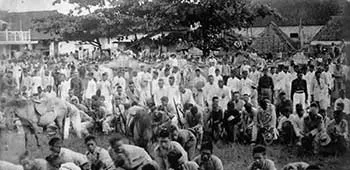An American Division Superintendent’s Description of Batangas in 1900-1901
[In this article: Batangas Province, American colonial era, education in Batangas, Philippine-American War, Education in the Philippine Islands, Report of the Commission on Education, General J. Franklin Bell, Superintendent M. A. Colton, District of Cavite, Tayabas and Batangas]
A short 1901 report1 by the newly appointed American superintendent for the Division of Cavite, Tayabas (presently Quezon Province) and Batangas provides some personal insights not just on the state of education in Batangas but, more importantly, some information about Batangueño culture at the time. The superintendent’s name was M. A. Colton.
Although the Philippine-American War was still raging in the period covered by the report – 1900-1901 – the infantile American colonial government was as busy introducing the Yank way of life to the Filipinos as its volunteer army was pursuing and subduing what to the American point of view were “Filipino insurgents.” One obvious tool for this “indoctrination” was education. In his 1989 book, author Stanley Karnow noted that “it (education) allowed it (the American colonial government) to spread their cultural values, particularly the English language, to the Filipino people2.”
The Commission on Education report was scathing of the previous Spanish colonial government’s policy on education, noting that while higher institutions – i.e. colleges and universities – had been in existence as early as the 17th century, there was nonetheless no logical policy for the opening of primary and secondary schools to feed these. Said the report:
“The result of this policy has been that a few persons have stood out prominently as educated Filipinos, while the great mass of the people have either not been educated at all or only up to a certain point, namely, the acquisition of the mechanical processes of reading and writing.”
The opening of these “lower education” schools, it goes without saying, had become a priority of the Americans even while the war had been ongoing. Districts of education had quickly been organized and superintendents appointed. Because of the dearth of schools at the time and the low population, it was but prudent to bundle the provinces of Batangas, Cavite and Tayabas into one district under Colton.
The Commission on Education report included short district reports from the different superintendents assigned around the Philippines. Each was likely given instructions to conduct an assessment of the assigned localities. Colton described his district as “Tagalo” – an alternative to Tagalog – country. He wrote:
“The division of Cavite, Tayabas, and Batangas is the Tagalo country. Batangas is the heart of it. Here in Batangas the Tagalo language is uncorrupted, comparatively speaking, and old Tagalo customs still hold.”
Moreover, Colton described the economic and political system still in use in Batangas as “feudal,” in reference to the medieval land distribution and re-distribution system in Europe which created a system of nobility3. The lands were then worked by peasants who were largely uneducated and under obligation to their feudal masters, the nobility.
In the Batangas, Colton observed, the role of the European feudal lords was played by the principalia, the “ruling and usually educated upper class in the pueblos of the Spanish Philippines4.” There was also a sort of caste system enforced that went along with the feudal system. He wrote:
“Caste is still recognized and somewhat well defined, although it shows some clear signs of breaking under certain influences of later years in addition to unfavorable environment of long standing, e. g., contact with Cayite, Manila, etc. In the first class are those who do no manual labor, including their women, who ‘toil not, neither do they spin;’ , the second consists of shopkeepers, etc.; the third class is composed of the common workman and laborer and of the rabble. The gulf between these classes is not impassable; wealth may bridge it.”
“His lord, or “principal,” the landed proprietor, in return cares for him, e. g., gives him floor space in which to put his “petati5” if becomes to town, or is “re-concentrated6” and is his protector if he is prosecuted or arrested. In short, the principal thinks for him. He digs, votes, and fights loyally for his lord.”
Although the Tagalog spoken in Batangas was pure, Spanish continued to be the “polite” and official language, presumably among the learned. Spanish was also more widely spoken in the province than in Cavite. This, Colton conjectured, was probably because of the “former wealth” of the principales in the former.
In conclusion, Colton gave a description of the concentration camps enforced in Batangas under the order of General J. Franklin Bell to prevent the civilian population from supplying the army of General Miguel Malvar. He wrote:
“At the beginning of the reconcentration, as many as a hundred hombres would be housed by one "lord" in his own house; now they have shacks. Owing to the conditions of sparse settlement of the barrios formerly, reconcentration is seen in model form at Tanauan, Batangas Province. Each barrio has its own square in the camp of nipa shacks, and each square has its schoolhouse. There are about 2,000 children enrolled, which is, it seems to me, unparalleled in the history of the world.”
2 “In our image: America's empire in the Philippines,” by Stanley Karnow, published 1989 in the United States, as quoted in Wikipedia.
3 “Medieval Life – What was the Feudal System?,” online at History on the Net.
4 “Principalia,” Wikipedia.
5 This writer is unable to determine what the “petati” was; probably archaic Batangas Tagalog.
6 The term “re-concentrated” was in reference to General J. Franklin Bell’s enforced concentration camp policy in Batangas during the Philippine-American War. Read more: “The Concentration Camp Policy that the US Army Used to Force the Surrender of Gen. Miguel Malvar.”

